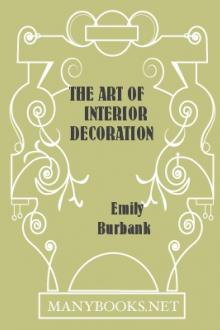The Art of Interior Decoration by Emily Burbank (good summer reads TXT) 📕

- Author: Emily Burbank
- Performer: -
Book online «The Art of Interior Decoration by Emily Burbank (good summer reads TXT) 📕». Author Emily Burbank
The table is modern, but made on the lines of a refectory table, well suited in length, width and solidity for board meetings, etc.
The chairs are Italian in style.
We grow up to, into, and out of colour schemes. Each of the Seven Ages of Man has its appropriate setting in colour as in line. One learns the dexterous manipulation of colour from furnishing, as an artist learns from painting.
Refuse to accept a colour scheme, unless it appeals to your individual taste—no matter who suggests it. To one not very sensitive to colour here is a valuable suggestion. Find a bit of beautiful old silk brocade, or a cretonne you especially like, and use its colour combinations for your room—a usual device of decorators. Let us suppose your silk or cretonne to have a deep-cream background, and scattered on it green foliage, faded salmon-pink roses and little, fine blue flowers. Use its prevailing colour, the deep cream, for walls and possibly woodwork; make the draperies of taffeta or rep in soft apple-greens; use the same colour for upholstery, make shades for lamp and electric lights of salmon-pink, then bring in a touch of blue in a sofa cushion, a footstool or small chair, or in a beautiful vase which charms by its shape as well by reproducing the exact tone of blue you desire. There are some who insist no room is complete without its note of blue. Many a room has been built up around some highly prized treasure,—lovely vase or an old Japanese print.
A thing always to be avoided is monotony in colour. Who can not recall barren rooms, without a spark of attraction despite priceless treasures, dispersed in a meaningless way? That sort of setting puts a blight on any gathering. "Well," you will ask, "given the task of converting such a sterile stretch of monotony into a blooming joy, how should one begin?" It is quite simple. Picture to yourself how the room would look if you scattered flowers about it, roses, tulips, mignonette, flowers of yellow and blue, in the pell-mell confusion of a blooming garden. Now imitate the flower colours by objets d'art so judiciously placed that in a trice you will admire what you once found cold. As if by magic, a white, cream, beige or grey room may be transformed into a smiling bower, teeming with personality, a room where wit and wisdom are spontaneously let loose.
If your taste be for chintzes and figured silks, take it as a safe rule, that given a material with a light background, it should be the same in tone as your walls; the idea being that by this method you get the full decorative value of the pattern on chintz or silk.
Figured materials can increase or diminish the size of a room, open up vistas, push back your walls, or block the vision. For this reason it is unsafe to buy material before trying the effect of it in its destined abode.
Remember that the matter of background is of the greatest importance when arranging your furniture and ornaments. See that your piano is so placed that the pianist has an unbroken background, of wall, tapestry, a large piece of rare old sills, or a mirror. Clyde Fitch, past-master at interior decoration, placed his piano in front of broad windows, across which at night were drawn crimson damask curtains. Some of us will never forget Geraldine Farrar, as she sat against that background wearing a dull, clinging blue-green gown, going over the score,—from memory,—of "Salomé."
The aim is to make the performer at the piano the object of interest, therefore place no diverting objects, such as pictures or ornaments, on a line with the listener's eye, except as a vague background.
There can be no more becoming setting for a group of people dining by candle or electric light, than walls panelled with dark wood to the ceiling, or a high wainscoting.
A beautiful sitting-room, not to be forgotten, had light violet walls, dull-gold frames on the furniture which was covered in deep-cream brocades, bits of old purple velvets and violet silks on the tables, under large bowls of Benares bronze filled with violets. The grand piano was protected by a piece of old brocade in faded yellows, and our hostess, a well-known singer, usually wore a simple Florentine tea-gown of soft violet velvet, which together with the lighter violet walls, set off her fair skin and black hair to beautiful advantage.
Put a figured, many-coloured sofa cushion behind the head of a pretty woman, and if the dominating colour is becoming to her, she is still pretty, but change it to a solid black, purple or dull-gold and see how instantly the degree of her beauty is enhanced by being thrown into relief.
Gives attractive corner by a window, the heavy silk brocade curtains of which are drawn. A standard electric lamp lights the desk, both modern-painted pieces, and the beautiful old flower picture, black background with a profusion of colours in lovely soft tones, is framed by a dull-gold moulding and gives immense distinction. The chair is Venetian Louis XV, the same period as desk in style.
Not to be ignored in this picture is a tin scrap basket beautifully proportioned and painted a vivid emerald green; a valuable addition a note of cheerful colour. The desk and wooden standard of lamp are painted a deep blue-plum colour, touched with gold, and the silk curtains are soft mulberry, in two tones.
Study values—just why and how much any decorative article decorates, and remember in furnishing a room, decorating a wall or dining-room table, it is not the intrinsic value or individual beauty of any one article which counts. Each picture on the wall, each piece of furniture, each bit of silver, glass, china, linen or lace, each yard of chintz or silk, every carpet or rug must be beautiful and effective in relation to the others used, for the art of interior decoration lies in this subtle, or obvious, relationship of furnishings.
We acknowledge as legitimate all schemes of interior decoration and insist that what makes any scheme good or bad, successful, or unsuccessful presuming a knowledge of the fundamentals of the art, is the fact that it is planned in reference to the type of man or woman who is to live in it.
A new note has been struck of late in the arranging of bizarre, delightful rooms which on entering we pronounce "very amusing."
Original they certainly are, in colour combinations, tropical in the impression they make,—or should we say Oriental?
They have come to us via Russia, Bakst, Munich and Martine of Paris. Like Rheinhardt's staging of "Sumurun," because these blazing interiors strike us at an unaccustomed angle, some are merely astonished, others charmed as well. There are temperaments ideally set in these interiors, and there are houses where they are in place. We cannot regard them as epoch-making, but granted that there is no attempt to conform to two of the rules for furnishing,—appropriateness and practicality, the results are refreshingly new and entertaining. This is one of the instances where exaggeration has served as a healthy antidote to the tendency toward extreme dinginess rampant about ten years ago, resulting from an obsession to antique everything. The reaction from this, a flaming rainbow of colours, struck a blow to the artistic sense, drew attention back to the value of colour and started the creative impulse along the line of a happy medium.
Whether it be a furnished porch, personal suite (as bedroom, boudoir and bath), a family living-room, dining-room, formal reception-room, or period ballroom, never allow members of your household or servants to destroy the effect you have achieved with careful thought and outlay of money, by ruthlessly moving chairs and tables from one room to another. Keep your wicker furniture on the porch, for which it was intended. If it strays into the adjacent living-room, done in quite another scheme, it will absolutely thwart your efforts at harmony, while your porch-room done in wicker and gay chintzes, striped awnings and geranium rail-boxes, cries out against the intrusion of a chair dragged out from the house. Remember that should you intend using your period ballroom from time to time as an audience room for concerts and lectures, you must provide a complete equipment of small, very light (so as to be quickly moved) chairs, in your "period," as a necessary part of your decoration.
The current idea that a distinguished room remains distinguished because costly tapestries and old masters hang on its walls, even when the floor is strewn with vulgar, hired chairs, is an absurd mistake. Each room from kitchen to ballroom is a stage "set,"—a harmonious background for certain scenes in life's drama. It is the man or woman who grasps this principle of a distinguished home who can create an interior which endures, one which will hold its own despite the ebb and flow of fashion. Imposing dimensions and great outlay of money do not necessarily imply distinction, a quality depending upon unerring good taste in the minutest details, one which may be achieved equally in a stately mansion, in a city flat, or in a cottage by the sea.
The question of background is absorbingly interesting. A vase, with or without flowers, to add to the composition of your room, that is, to make "a good picture," must be placed so that its background sets it off. Let the Venetian glass vase holding one rose stand in such a position that your green curtain is its background, and not a photograph or other picture. One flower, carefully placed in a room, will have more real decorative value than dozens of costly roses strewn about in the wrong vases, against mottled, line-destroying backgrounds.
Flowers are always more beautiful in a plain vase, whether of glass, pottery, porcelain or silver. If a vase chances to have a decoration in colour, then make a point of having the flowers it holds accord in colour, if not in shade, with the colour or colours in the vase.
There is a general rule that no ornament should ever be placed in front of a picture. The exception to this rule occurs when the picture is one of the large, architectural variety, whose purpose is primarily mural decoration,—an intentional background, as tapestries often are, serving its purpose as nature does when a vase or statue is placed in a park or garden. One sees in portraits by some of the old masters this idea of landscape used as background. Bear in mind, however, that if there is a central design—a definite composition in the picture, or tapestry, no ornament should ever be so placed as to interfere with it. If you happen to own a tapestry which is not large enough for your space by one,





Comments (0)